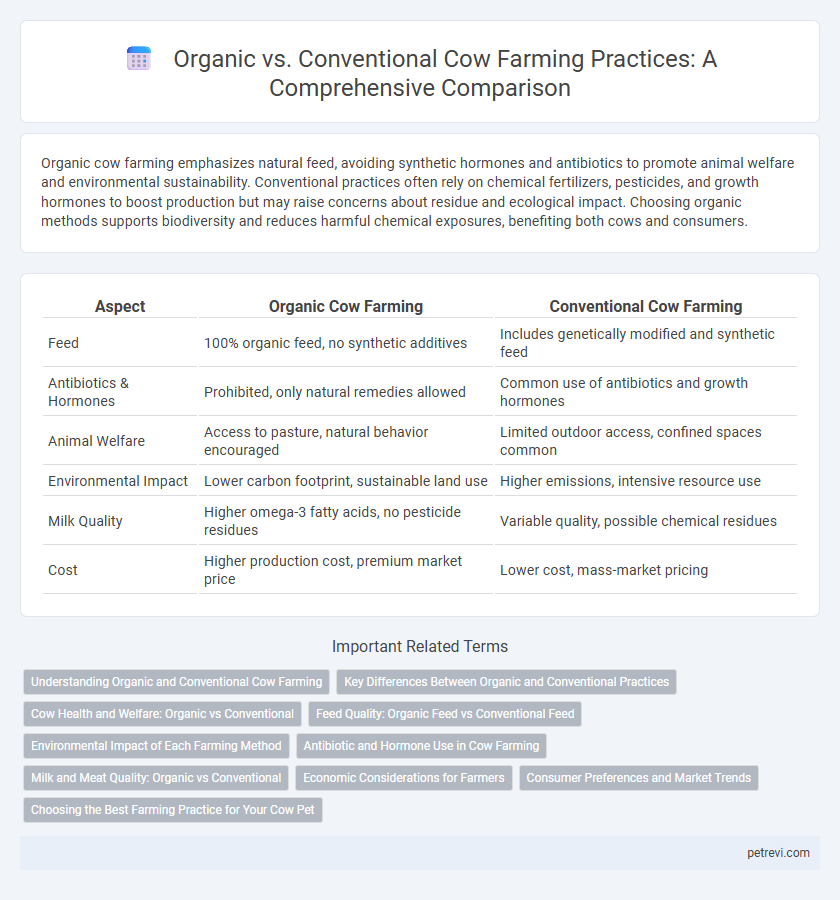Organic cow farming emphasizes natural feed, avoiding synthetic hormones and antibiotics to promote animal welfare and environmental sustainability. Conventional practices often rely on chemical fertilizers, pesticides, and growth hormones to boost production but may raise concerns about residue and ecological impact. Choosing organic methods supports biodiversity and reduces harmful chemical exposures, benefiting both cows and consumers.
Table of Comparison
| Aspect | Organic Cow Farming | Conventional Cow Farming |
|---|---|---|
| Feed | 100% organic feed, no synthetic additives | Includes genetically modified and synthetic feed |
| Antibiotics & Hormones | Prohibited, only natural remedies allowed | Common use of antibiotics and growth hormones |
| Animal Welfare | Access to pasture, natural behavior encouraged | Limited outdoor access, confined spaces common |
| Environmental Impact | Lower carbon footprint, sustainable land use | Higher emissions, intensive resource use |
| Milk Quality | Higher omega-3 fatty acids, no pesticide residues | Variable quality, possible chemical residues |
| Cost | Higher production cost, premium market price | Lower cost, mass-market pricing |
Understanding Organic and Conventional Cow Farming
Organic cow farming emphasizes natural feed, pasture grazing, and prohibits synthetic hormones and antibiotics, promoting animal welfare and environmental sustainability. Conventional cow farming often relies on genetically modified feed, confined housing, and routine antibiotic use to maximize productivity and control disease. Understanding these practices highlights the trade-offs between ecological impact, animal health, and production efficiency in the dairy and beef industries.
Key Differences Between Organic and Conventional Practices
Organic cow farming emphasizes natural feed, prohibits synthetic hormones and antibiotics, and promotes pasture access to enhance animal welfare and environmental sustainability. Conventional practices often rely on grain-based feeds, synthetic growth promoters, and routine antibiotic use aimed at maximizing production efficiency. Organic methods prioritize soil health and biodiversity, while conventional systems focus on higher yield and cost-effectiveness through intensive farming techniques.
Cow Health and Welfare: Organic vs Conventional
Organic cow farming prioritizes animal health and welfare by providing cows with access to pasture, organic feed, and restricted use of antibiotics, promoting natural behaviors and reducing exposure to synthetic chemicals. Conventional farming often relies on confined housing, rapid growth practices, and routine antibiotic use, which can increase stress and susceptibility to diseases in cows. Studies show organic cows generally exhibit lower instances of lameness and mastitis, reflecting improved welfare conditions compared to conventional systems.
Feed Quality: Organic Feed vs Conventional Feed
Organic feed for cow farming consists of non-GMO grains, legumes, and forage grown without synthetic pesticides or fertilizers, promoting improved nutrient density and reducing exposure to harmful chemicals. Conventional feed often includes genetically modified ingredients and synthetic additives to enhance growth and feed efficiency but may carry residues of pesticides and antibiotics. Studies indicate that organic feed can positively impact milk quality by increasing beneficial fatty acids and antioxidants compared to conventional feed.
Environmental Impact of Each Farming Method
Organic cow farming reduces environmental impact through the avoidance of synthetic fertilizers and pesticides, promoting healthier soil and biodiversity. Conventional farming often relies on chemical inputs and intensive resource use, leading to higher greenhouse gas emissions and water pollution. Sustainable organic practices contribute to lower carbon footprints and improved ecosystem resilience compared to conventional methods.
Antibiotic and Hormone Use in Cow Farming
Organic cow farming strictly prohibits the use of synthetic antibiotics and hormones, promoting animal health through natural remedies and rotational grazing to prevent disease. Conventional cow farming often relies on antibiotics and growth hormones to accelerate milk production and treat infections, which raises concerns about antibiotic resistance and hormone residues in dairy products. Choosing organic practices supports sustainable agriculture and reduces exposure to synthetic substances in the food supply.
Milk and Meat Quality: Organic vs Conventional
Organic cow farming prioritizes natural feed and prohibits synthetic hormones, resulting in milk and meat with higher levels of omega-3 fatty acids and antioxidants compared to conventional methods. Conventional farming often uses grain-based feed and growth hormones, which can lead to faster production but may reduce nutrient density and increase residue risks in milk and meat. Studies indicate that organic dairy and beef products typically offer better fatty acid profiles and lower exposure to antibiotic residues.
Economic Considerations for Farmers
Organic cow farming often incurs higher production costs due to the need for certified organic feed, pasture management, and stricter animal welfare standards. Conventional farming typically benefits from economies of scale, lower input costs, and higher milk yields, contributing to greater short-term profitability. Market demand for organic dairy products can lead to premium prices, potentially offsetting increased costs and influencing farmers' economic decisions.
Consumer Preferences and Market Trends
Organic cow farming emphasizes natural feed, free-range grazing, and avoidance of synthetic hormones, attracting health-conscious consumers seeking antibiotic-free, hormone-free dairy and beef products. Conventional practices often rely on higher-density operations and synthetic inputs, appealing to cost-sensitive buyers due to lower prices and consistent supply. Market trends show increasing demand for organic products driven by consumer awareness of animal welfare and environmental sustainability, leading to a growing share of premium-priced organic milk and beef in global retail.
Choosing the Best Farming Practice for Your Cow Pet
Choosing between organic and conventional cow farming practices depends on factors such as animal health, environmental impact, and product quality. Organic farming emphasizes natural feed, no synthetic hormones or antibiotics, and access to pasture, enhancing cow welfare and reducing chemical residues in milk and meat. Conventional farming may offer higher productivity and lower costs but often involves synthetic inputs and confined housing, potentially affecting animal well-being and sustainability.
Organic vs Conventional for Cow Farming Practice Infographic

 petrevi.com
petrevi.com